Research Design and Methodology Report: Chicago Youth Study
VerifiedAdded on 2023/01/03
|10
|2559
|1
Report
AI Summary
This report details the research design and methodology for a study investigating the correlation between sexual orientation, body mass index, and methamphetamine use among Chicago youth. The study employs a qualitative experimental design, collecting data through validated interview questionnaires and dividing participants into intervention and control groups. The intervention group receives methamphetamine addressing the issue of sexual orientation, body mass index, while the control group does not. Data collection involves semi-structured interviews and utilizes a sample frame incorporating statistical data from the department of health. The report addresses sample size determination, sampling procedures, and the significance of qualitative interviews for exploring the impact of methamphetamine use on decision-making processes related to sexual orientation and body mass index. The report emphasizes the importance of active listening, proper interview settings, and the use of prompts to ensure comprehensive data collection. Furthermore, it outlines the operationalization of variables and the comparison of outcomes between the intervention and control groups.
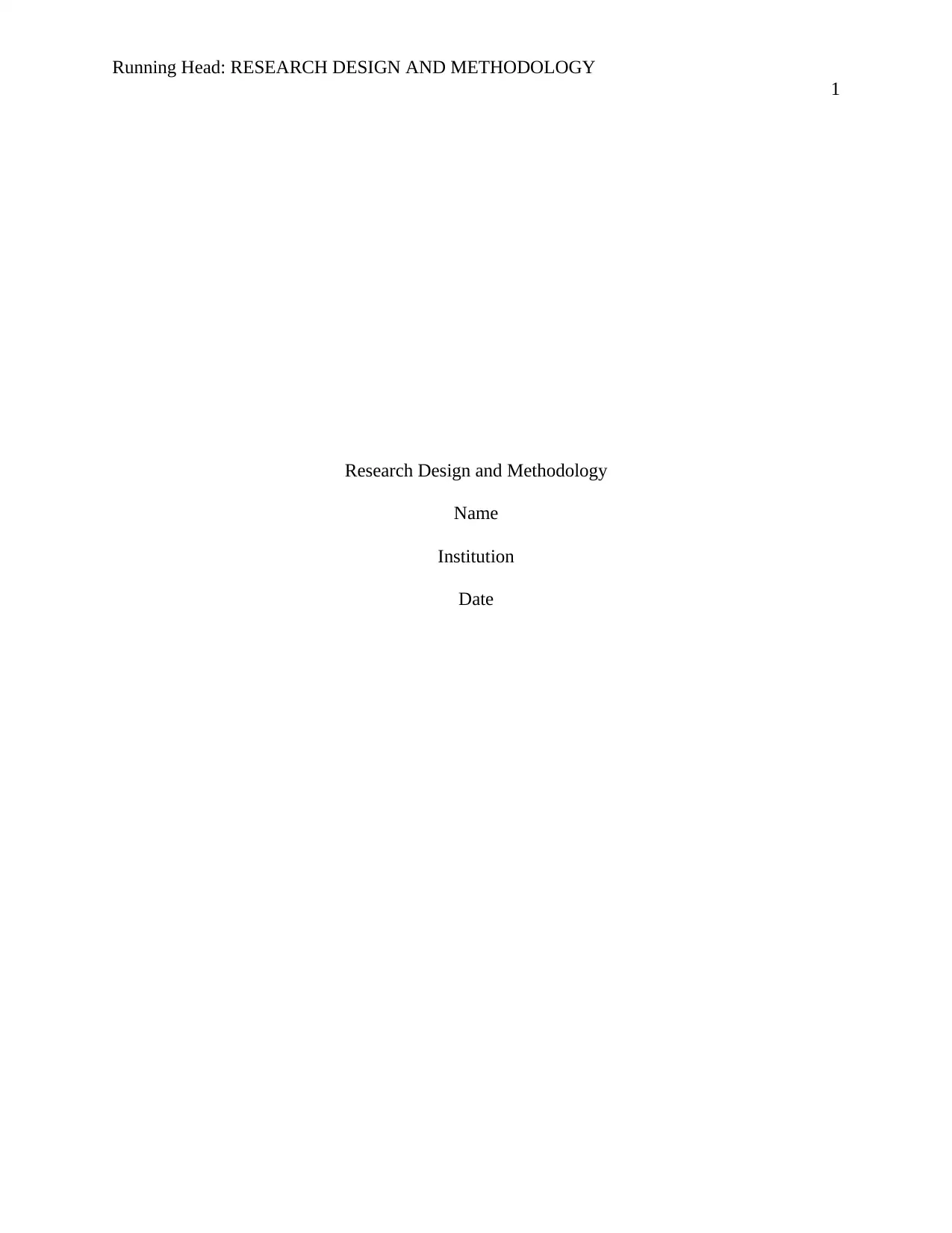
Running Head: RESEARCH DESIGN AND METHODOLOGY
1
Research Design and Methodology
Name
Institution
Date
1
Research Design and Methodology
Name
Institution
Date
Paraphrase This Document
Need a fresh take? Get an instant paraphrase of this document with our AI Paraphraser
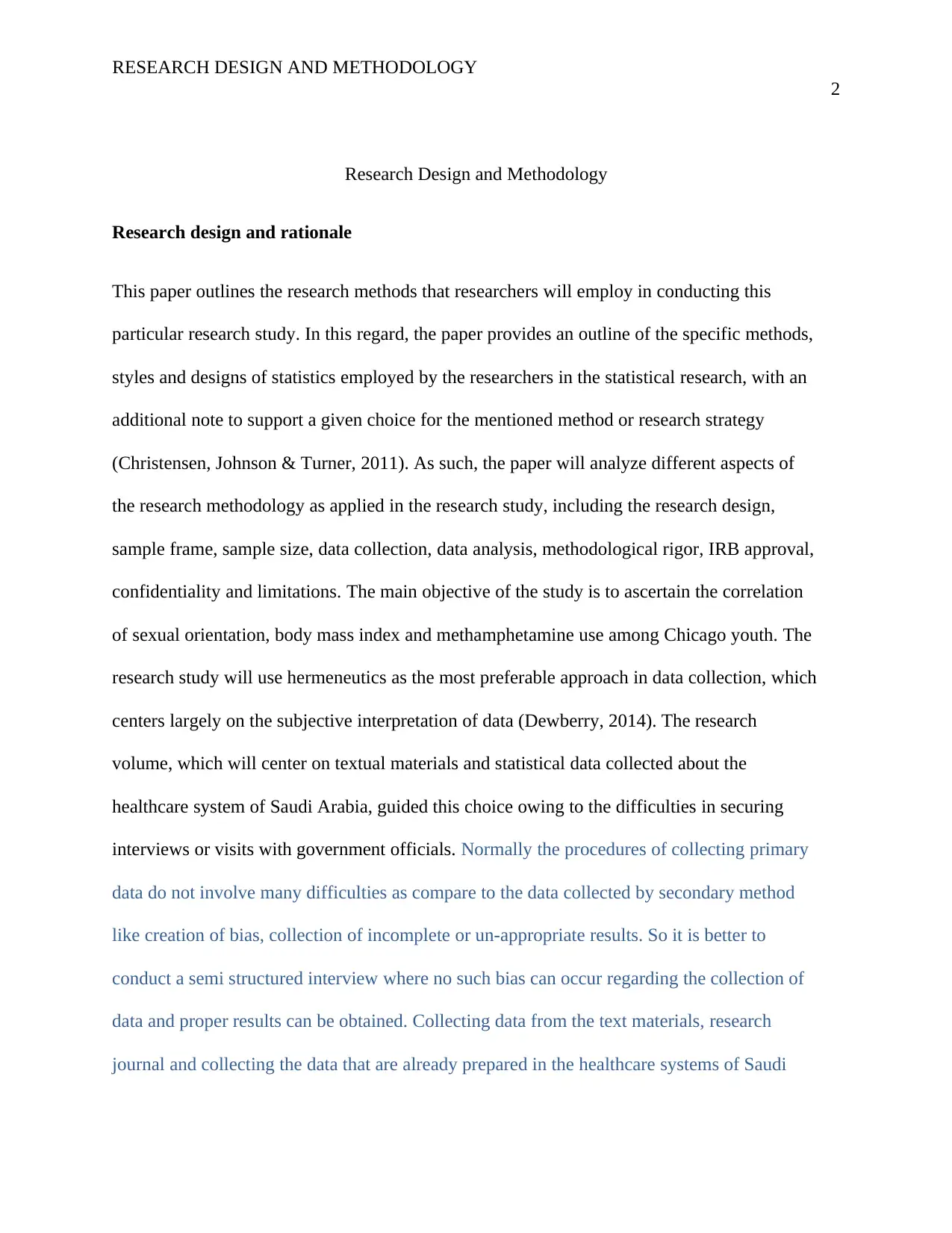
RESEARCH DESIGN AND METHODOLOGY
2
Research Design and Methodology
Research design and rationale
This paper outlines the research methods that researchers will employ in conducting this
particular research study. In this regard, the paper provides an outline of the specific methods,
styles and designs of statistics employed by the researchers in the statistical research, with an
additional note to support a given choice for the mentioned method or research strategy
(Christensen, Johnson & Turner, 2011). As such, the paper will analyze different aspects of
the research methodology as applied in the research study, including the research design,
sample frame, sample size, data collection, data analysis, methodological rigor, IRB approval,
confidentiality and limitations. The main objective of the study is to ascertain the correlation
of sexual orientation, body mass index and methamphetamine use among Chicago youth. The
research study will use hermeneutics as the most preferable approach in data collection, which
centers largely on the subjective interpretation of data (Dewberry, 2014). The research
volume, which will center on textual materials and statistical data collected about the
healthcare system of Saudi Arabia, guided this choice owing to the difficulties in securing
interviews or visits with government officials. Normally the procedures of collecting primary
data do not involve many difficulties as compare to the data collected by secondary method
like creation of bias, collection of incomplete or un-appropriate results. So it is better to
conduct a semi structured interview where no such bias can occur regarding the collection of
data and proper results can be obtained. Collecting data from the text materials, research
journal and collecting the data that are already prepared in the healthcare systems of Saudi
2
Research Design and Methodology
Research design and rationale
This paper outlines the research methods that researchers will employ in conducting this
particular research study. In this regard, the paper provides an outline of the specific methods,
styles and designs of statistics employed by the researchers in the statistical research, with an
additional note to support a given choice for the mentioned method or research strategy
(Christensen, Johnson & Turner, 2011). As such, the paper will analyze different aspects of
the research methodology as applied in the research study, including the research design,
sample frame, sample size, data collection, data analysis, methodological rigor, IRB approval,
confidentiality and limitations. The main objective of the study is to ascertain the correlation
of sexual orientation, body mass index and methamphetamine use among Chicago youth. The
research study will use hermeneutics as the most preferable approach in data collection, which
centers largely on the subjective interpretation of data (Dewberry, 2014). The research
volume, which will center on textual materials and statistical data collected about the
healthcare system of Saudi Arabia, guided this choice owing to the difficulties in securing
interviews or visits with government officials. Normally the procedures of collecting primary
data do not involve many difficulties as compare to the data collected by secondary method
like creation of bias, collection of incomplete or un-appropriate results. So it is better to
conduct a semi structured interview where no such bias can occur regarding the collection of
data and proper results can be obtained. Collecting data from the text materials, research
journal and collecting the data that are already prepared in the healthcare systems of Saudi
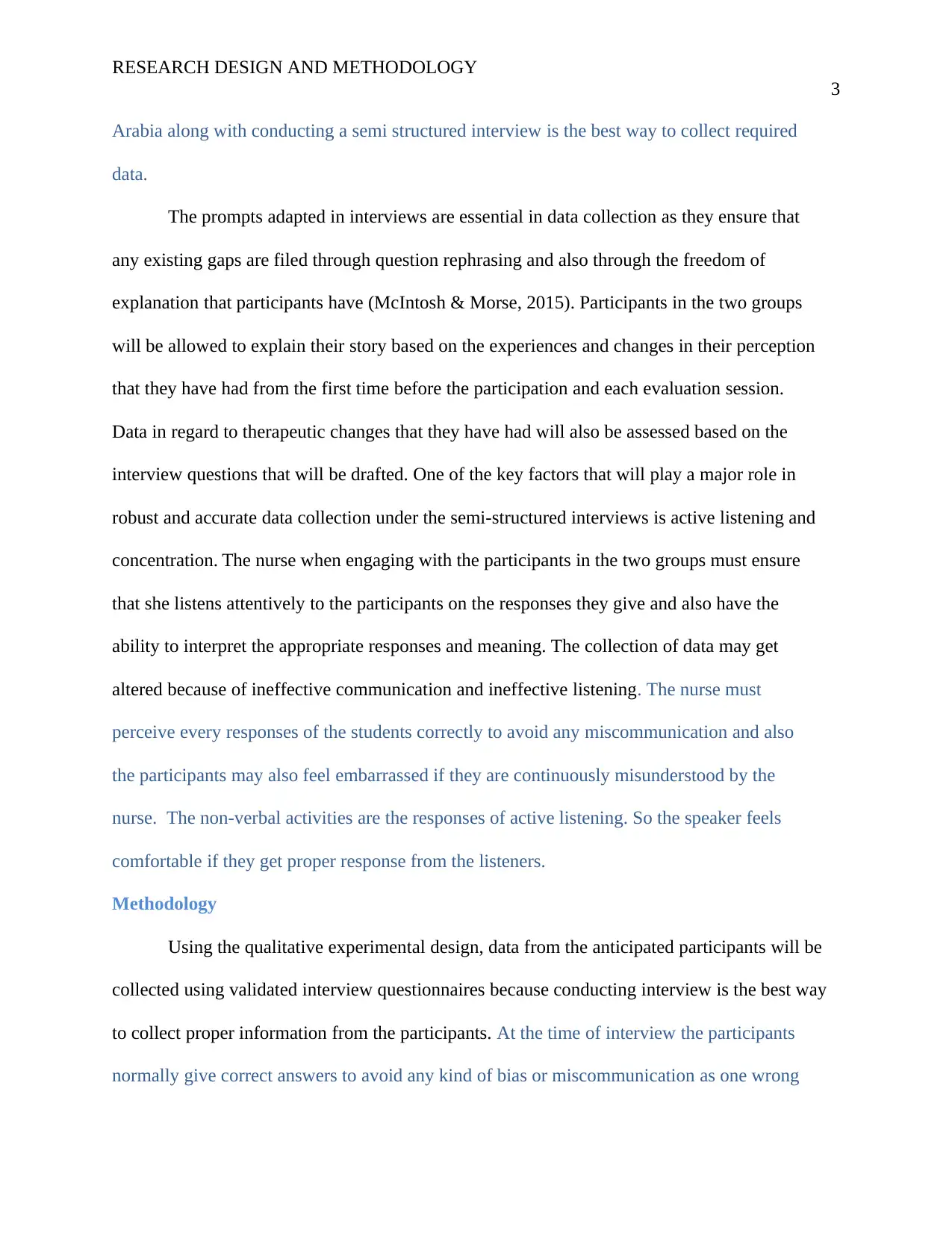
RESEARCH DESIGN AND METHODOLOGY
3
Arabia along with conducting a semi structured interview is the best way to collect required
data.
The prompts adapted in interviews are essential in data collection as they ensure that
any existing gaps are filed through question rephrasing and also through the freedom of
explanation that participants have (McIntosh & Morse, 2015). Participants in the two groups
will be allowed to explain their story based on the experiences and changes in their perception
that they have had from the first time before the participation and each evaluation session.
Data in regard to therapeutic changes that they have had will also be assessed based on the
interview questions that will be drafted. One of the key factors that will play a major role in
robust and accurate data collection under the semi-structured interviews is active listening and
concentration. The nurse when engaging with the participants in the two groups must ensure
that she listens attentively to the participants on the responses they give and also have the
ability to interpret the appropriate responses and meaning. The collection of data may get
altered because of ineffective communication and ineffective listening. The nurse must
perceive every responses of the students correctly to avoid any miscommunication and also
the participants may also feel embarrassed if they are continuously misunderstood by the
nurse. The non-verbal activities are the responses of active listening. So the speaker feels
comfortable if they get proper response from the listeners.
Methodology
Using the qualitative experimental design, data from the anticipated participants will be
collected using validated interview questionnaires because conducting interview is the best way
to collect proper information from the participants. At the time of interview the participants
normally give correct answers to avoid any kind of bias or miscommunication as one wrong
3
Arabia along with conducting a semi structured interview is the best way to collect required
data.
The prompts adapted in interviews are essential in data collection as they ensure that
any existing gaps are filed through question rephrasing and also through the freedom of
explanation that participants have (McIntosh & Morse, 2015). Participants in the two groups
will be allowed to explain their story based on the experiences and changes in their perception
that they have had from the first time before the participation and each evaluation session.
Data in regard to therapeutic changes that they have had will also be assessed based on the
interview questions that will be drafted. One of the key factors that will play a major role in
robust and accurate data collection under the semi-structured interviews is active listening and
concentration. The nurse when engaging with the participants in the two groups must ensure
that she listens attentively to the participants on the responses they give and also have the
ability to interpret the appropriate responses and meaning. The collection of data may get
altered because of ineffective communication and ineffective listening. The nurse must
perceive every responses of the students correctly to avoid any miscommunication and also
the participants may also feel embarrassed if they are continuously misunderstood by the
nurse. The non-verbal activities are the responses of active listening. So the speaker feels
comfortable if they get proper response from the listeners.
Methodology
Using the qualitative experimental design, data from the anticipated participants will be
collected using validated interview questionnaires because conducting interview is the best way
to collect proper information from the participants. At the time of interview the participants
normally give correct answers to avoid any kind of bias or miscommunication as one wrong
⊘ This is a preview!⊘
Do you want full access?
Subscribe today to unlock all pages.

Trusted by 1+ million students worldwide
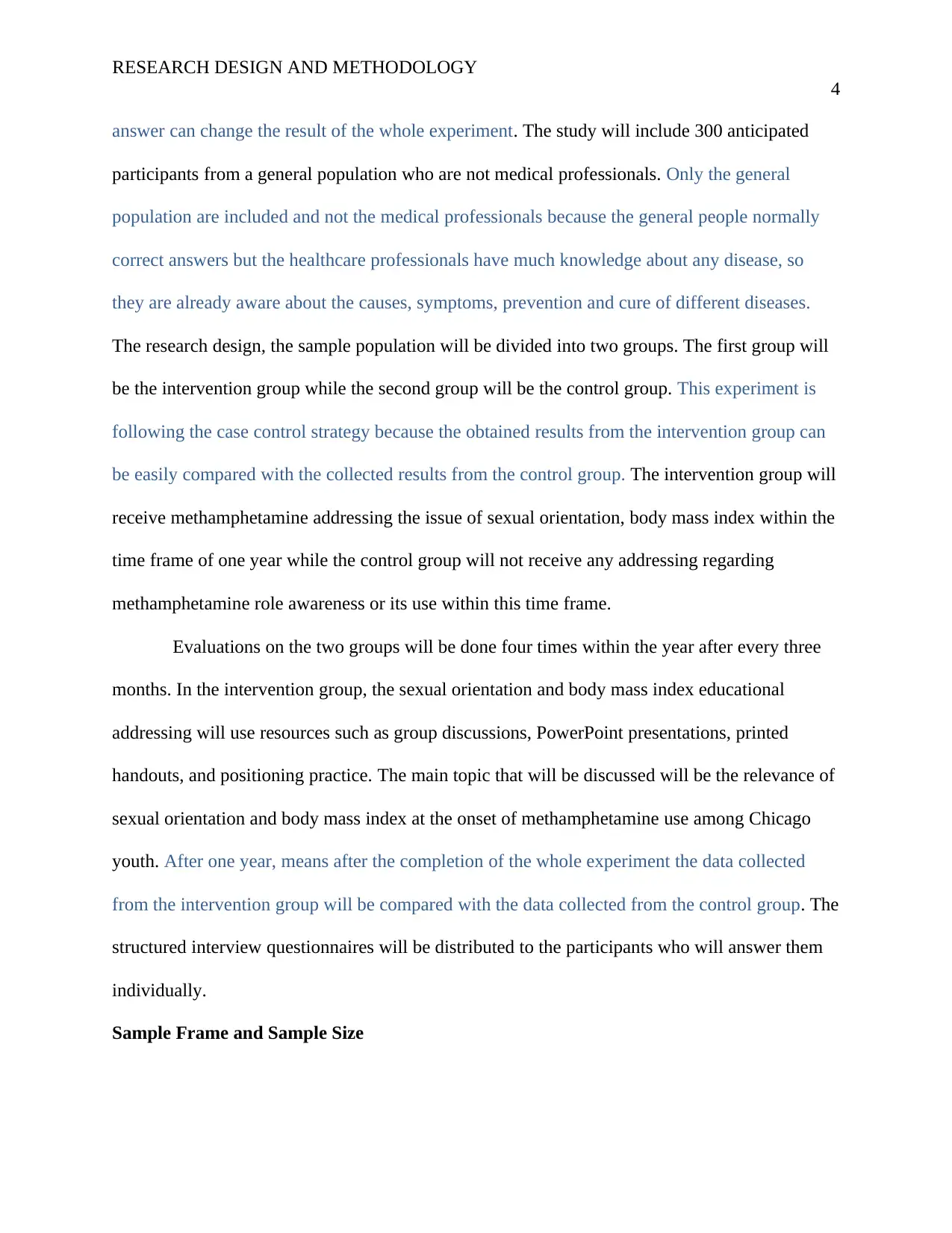
RESEARCH DESIGN AND METHODOLOGY
4
answer can change the result of the whole experiment. The study will include 300 anticipated
participants from a general population who are not medical professionals. Only the general
population are included and not the medical professionals because the general people normally
correct answers but the healthcare professionals have much knowledge about any disease, so
they are already aware about the causes, symptoms, prevention and cure of different diseases.
The research design, the sample population will be divided into two groups. The first group will
be the intervention group while the second group will be the control group. This experiment is
following the case control strategy because the obtained results from the intervention group can
be easily compared with the collected results from the control group. The intervention group will
receive methamphetamine addressing the issue of sexual orientation, body mass index within the
time frame of one year while the control group will not receive any addressing regarding
methamphetamine role awareness or its use within this time frame.
Evaluations on the two groups will be done four times within the year after every three
months. In the intervention group, the sexual orientation and body mass index educational
addressing will use resources such as group discussions, PowerPoint presentations, printed
handouts, and positioning practice. The main topic that will be discussed will be the relevance of
sexual orientation and body mass index at the onset of methamphetamine use among Chicago
youth. After one year, means after the completion of the whole experiment the data collected
from the intervention group will be compared with the data collected from the control group. The
structured interview questionnaires will be distributed to the participants who will answer them
individually.
Sample Frame and Sample Size
4
answer can change the result of the whole experiment. The study will include 300 anticipated
participants from a general population who are not medical professionals. Only the general
population are included and not the medical professionals because the general people normally
correct answers but the healthcare professionals have much knowledge about any disease, so
they are already aware about the causes, symptoms, prevention and cure of different diseases.
The research design, the sample population will be divided into two groups. The first group will
be the intervention group while the second group will be the control group. This experiment is
following the case control strategy because the obtained results from the intervention group can
be easily compared with the collected results from the control group. The intervention group will
receive methamphetamine addressing the issue of sexual orientation, body mass index within the
time frame of one year while the control group will not receive any addressing regarding
methamphetamine role awareness or its use within this time frame.
Evaluations on the two groups will be done four times within the year after every three
months. In the intervention group, the sexual orientation and body mass index educational
addressing will use resources such as group discussions, PowerPoint presentations, printed
handouts, and positioning practice. The main topic that will be discussed will be the relevance of
sexual orientation and body mass index at the onset of methamphetamine use among Chicago
youth. After one year, means after the completion of the whole experiment the data collected
from the intervention group will be compared with the data collected from the control group. The
structured interview questionnaires will be distributed to the participants who will answer them
individually.
Sample Frame and Sample Size
Paraphrase This Document
Need a fresh take? Get an instant paraphrase of this document with our AI Paraphraser
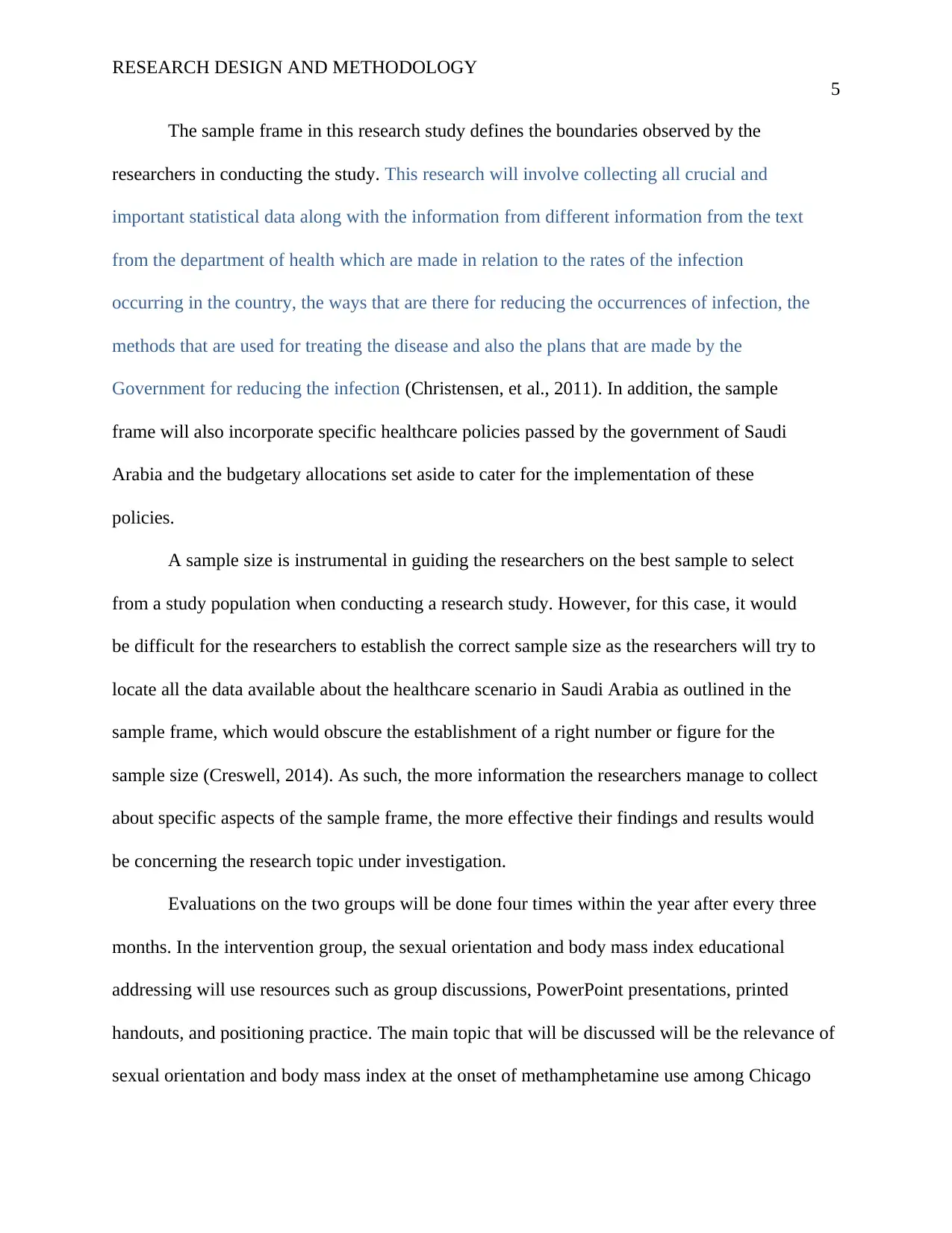
RESEARCH DESIGN AND METHODOLOGY
5
The sample frame in this research study defines the boundaries observed by the
researchers in conducting the study. This research will involve collecting all crucial and
important statistical data along with the information from different information from the text
from the department of health which are made in relation to the rates of the infection
occurring in the country, the ways that are there for reducing the occurrences of infection, the
methods that are used for treating the disease and also the plans that are made by the
Government for reducing the infection (Christensen, et al., 2011). In addition, the sample
frame will also incorporate specific healthcare policies passed by the government of Saudi
Arabia and the budgetary allocations set aside to cater for the implementation of these
policies.
A sample size is instrumental in guiding the researchers on the best sample to select
from a study population when conducting a research study. However, for this case, it would
be difficult for the researchers to establish the correct sample size as the researchers will try to
locate all the data available about the healthcare scenario in Saudi Arabia as outlined in the
sample frame, which would obscure the establishment of a right number or figure for the
sample size (Creswell, 2014). As such, the more information the researchers manage to collect
about specific aspects of the sample frame, the more effective their findings and results would
be concerning the research topic under investigation.
Evaluations on the two groups will be done four times within the year after every three
months. In the intervention group, the sexual orientation and body mass index educational
addressing will use resources such as group discussions, PowerPoint presentations, printed
handouts, and positioning practice. The main topic that will be discussed will be the relevance of
sexual orientation and body mass index at the onset of methamphetamine use among Chicago
5
The sample frame in this research study defines the boundaries observed by the
researchers in conducting the study. This research will involve collecting all crucial and
important statistical data along with the information from different information from the text
from the department of health which are made in relation to the rates of the infection
occurring in the country, the ways that are there for reducing the occurrences of infection, the
methods that are used for treating the disease and also the plans that are made by the
Government for reducing the infection (Christensen, et al., 2011). In addition, the sample
frame will also incorporate specific healthcare policies passed by the government of Saudi
Arabia and the budgetary allocations set aside to cater for the implementation of these
policies.
A sample size is instrumental in guiding the researchers on the best sample to select
from a study population when conducting a research study. However, for this case, it would
be difficult for the researchers to establish the correct sample size as the researchers will try to
locate all the data available about the healthcare scenario in Saudi Arabia as outlined in the
sample frame, which would obscure the establishment of a right number or figure for the
sample size (Creswell, 2014). As such, the more information the researchers manage to collect
about specific aspects of the sample frame, the more effective their findings and results would
be concerning the research topic under investigation.
Evaluations on the two groups will be done four times within the year after every three
months. In the intervention group, the sexual orientation and body mass index educational
addressing will use resources such as group discussions, PowerPoint presentations, printed
handouts, and positioning practice. The main topic that will be discussed will be the relevance of
sexual orientation and body mass index at the onset of methamphetamine use among Chicago
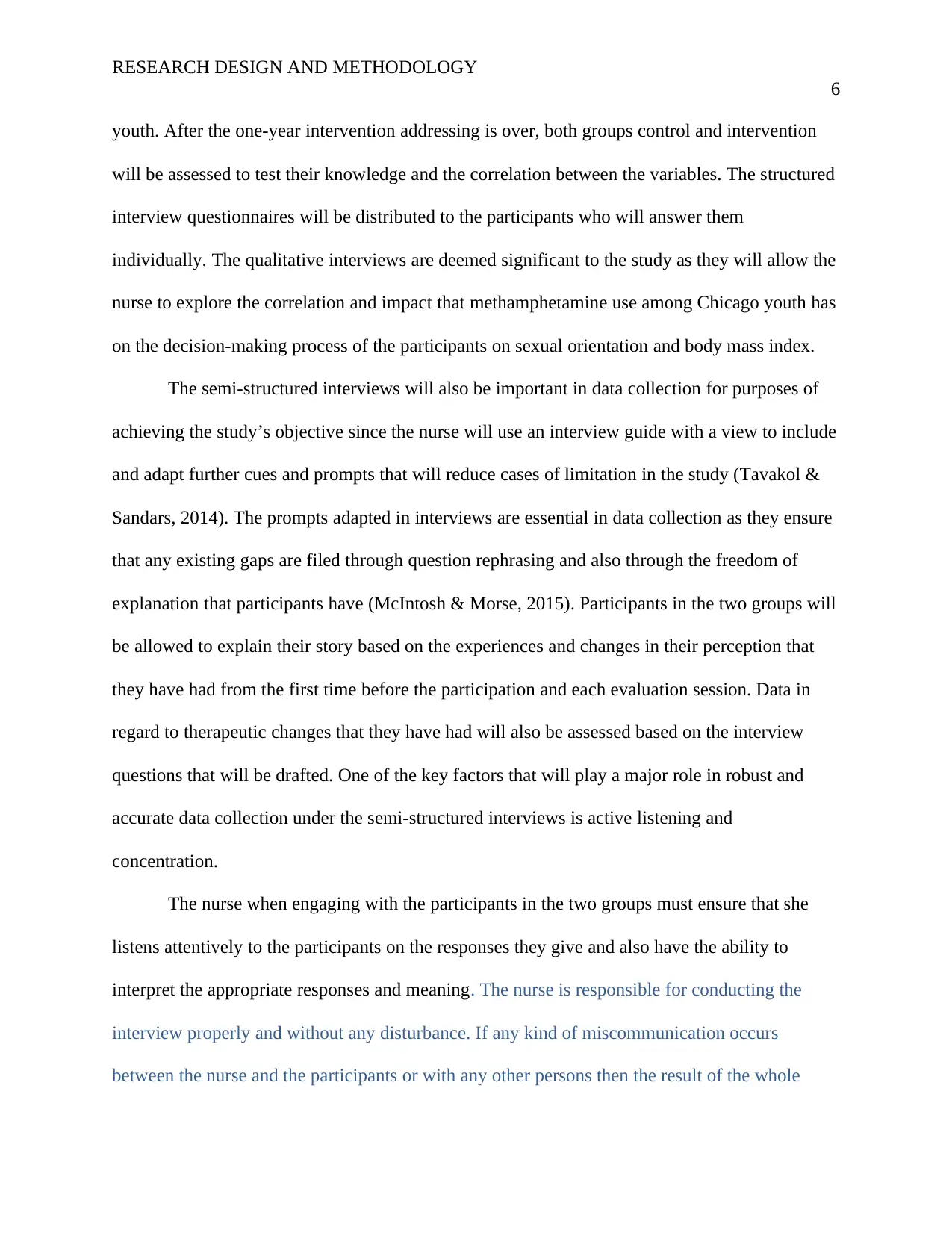
RESEARCH DESIGN AND METHODOLOGY
6
youth. After the one-year intervention addressing is over, both groups control and intervention
will be assessed to test their knowledge and the correlation between the variables. The structured
interview questionnaires will be distributed to the participants who will answer them
individually. The qualitative interviews are deemed significant to the study as they will allow the
nurse to explore the correlation and impact that methamphetamine use among Chicago youth has
on the decision-making process of the participants on sexual orientation and body mass index.
The semi-structured interviews will also be important in data collection for purposes of
achieving the study’s objective since the nurse will use an interview guide with a view to include
and adapt further cues and prompts that will reduce cases of limitation in the study (Tavakol &
Sandars, 2014). The prompts adapted in interviews are essential in data collection as they ensure
that any existing gaps are filed through question rephrasing and also through the freedom of
explanation that participants have (McIntosh & Morse, 2015). Participants in the two groups will
be allowed to explain their story based on the experiences and changes in their perception that
they have had from the first time before the participation and each evaluation session. Data in
regard to therapeutic changes that they have had will also be assessed based on the interview
questions that will be drafted. One of the key factors that will play a major role in robust and
accurate data collection under the semi-structured interviews is active listening and
concentration.
The nurse when engaging with the participants in the two groups must ensure that she
listens attentively to the participants on the responses they give and also have the ability to
interpret the appropriate responses and meaning. The nurse is responsible for conducting the
interview properly and without any disturbance. If any kind of miscommunication occurs
between the nurse and the participants or with any other persons then the result of the whole
6
youth. After the one-year intervention addressing is over, both groups control and intervention
will be assessed to test their knowledge and the correlation between the variables. The structured
interview questionnaires will be distributed to the participants who will answer them
individually. The qualitative interviews are deemed significant to the study as they will allow the
nurse to explore the correlation and impact that methamphetamine use among Chicago youth has
on the decision-making process of the participants on sexual orientation and body mass index.
The semi-structured interviews will also be important in data collection for purposes of
achieving the study’s objective since the nurse will use an interview guide with a view to include
and adapt further cues and prompts that will reduce cases of limitation in the study (Tavakol &
Sandars, 2014). The prompts adapted in interviews are essential in data collection as they ensure
that any existing gaps are filed through question rephrasing and also through the freedom of
explanation that participants have (McIntosh & Morse, 2015). Participants in the two groups will
be allowed to explain their story based on the experiences and changes in their perception that
they have had from the first time before the participation and each evaluation session. Data in
regard to therapeutic changes that they have had will also be assessed based on the interview
questions that will be drafted. One of the key factors that will play a major role in robust and
accurate data collection under the semi-structured interviews is active listening and
concentration.
The nurse when engaging with the participants in the two groups must ensure that she
listens attentively to the participants on the responses they give and also have the ability to
interpret the appropriate responses and meaning. The nurse is responsible for conducting the
interview properly and without any disturbance. If any kind of miscommunication occurs
between the nurse and the participants or with any other persons then the result of the whole
⊘ This is a preview!⊘
Do you want full access?
Subscribe today to unlock all pages.

Trusted by 1+ million students worldwide
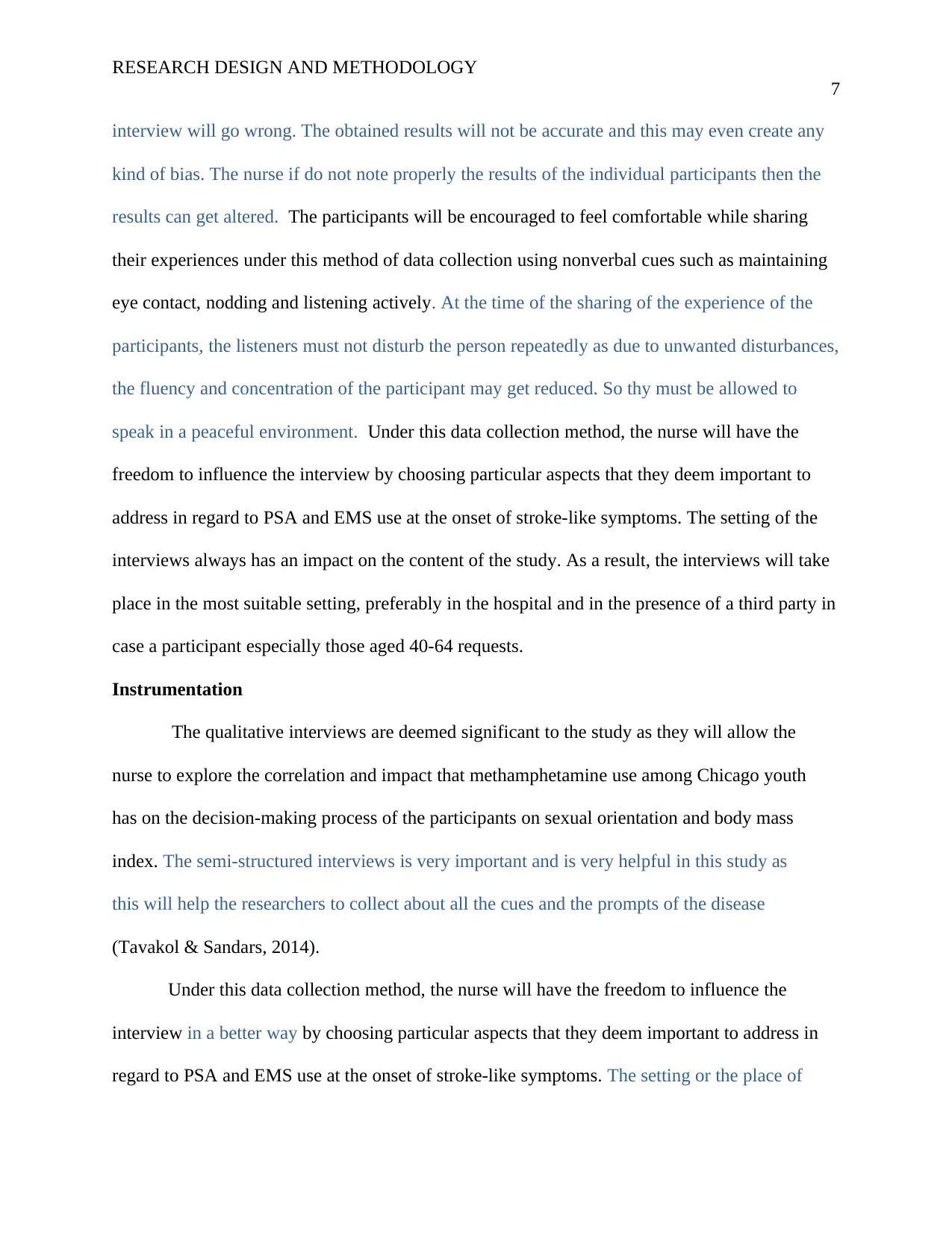
RESEARCH DESIGN AND METHODOLOGY
7
interview will go wrong. The obtained results will not be accurate and this may even create any
kind of bias. The nurse if do not note properly the results of the individual participants then the
results can get altered. The participants will be encouraged to feel comfortable while sharing
their experiences under this method of data collection using nonverbal cues such as maintaining
eye contact, nodding and listening actively. At the time of the sharing of the experience of the
participants, the listeners must not disturb the person repeatedly as due to unwanted disturbances,
the fluency and concentration of the participant may get reduced. So thy must be allowed to
speak in a peaceful environment. Under this data collection method, the nurse will have the
freedom to influence the interview by choosing particular aspects that they deem important to
address in regard to PSA and EMS use at the onset of stroke-like symptoms. The setting of the
interviews always has an impact on the content of the study. As a result, the interviews will take
place in the most suitable setting, preferably in the hospital and in the presence of a third party in
case a participant especially those aged 40-64 requests.
Instrumentation
The qualitative interviews are deemed significant to the study as they will allow the
nurse to explore the correlation and impact that methamphetamine use among Chicago youth
has on the decision-making process of the participants on sexual orientation and body mass
index. The semi-structured interviews is very important and is very helpful in this study as
this will help the researchers to collect about all the cues and the prompts of the disease
(Tavakol & Sandars, 2014).
Under this data collection method, the nurse will have the freedom to influence the
interview in a better way by choosing particular aspects that they deem important to address in
regard to PSA and EMS use at the onset of stroke-like symptoms. The setting or the place of
7
interview will go wrong. The obtained results will not be accurate and this may even create any
kind of bias. The nurse if do not note properly the results of the individual participants then the
results can get altered. The participants will be encouraged to feel comfortable while sharing
their experiences under this method of data collection using nonverbal cues such as maintaining
eye contact, nodding and listening actively. At the time of the sharing of the experience of the
participants, the listeners must not disturb the person repeatedly as due to unwanted disturbances,
the fluency and concentration of the participant may get reduced. So thy must be allowed to
speak in a peaceful environment. Under this data collection method, the nurse will have the
freedom to influence the interview by choosing particular aspects that they deem important to
address in regard to PSA and EMS use at the onset of stroke-like symptoms. The setting of the
interviews always has an impact on the content of the study. As a result, the interviews will take
place in the most suitable setting, preferably in the hospital and in the presence of a third party in
case a participant especially those aged 40-64 requests.
Instrumentation
The qualitative interviews are deemed significant to the study as they will allow the
nurse to explore the correlation and impact that methamphetamine use among Chicago youth
has on the decision-making process of the participants on sexual orientation and body mass
index. The semi-structured interviews is very important and is very helpful in this study as
this will help the researchers to collect about all the cues and the prompts of the disease
(Tavakol & Sandars, 2014).
Under this data collection method, the nurse will have the freedom to influence the
interview in a better way by choosing particular aspects that they deem important to address in
regard to PSA and EMS use at the onset of stroke-like symptoms. The setting or the place of
Paraphrase This Document
Need a fresh take? Get an instant paraphrase of this document with our AI Paraphraser
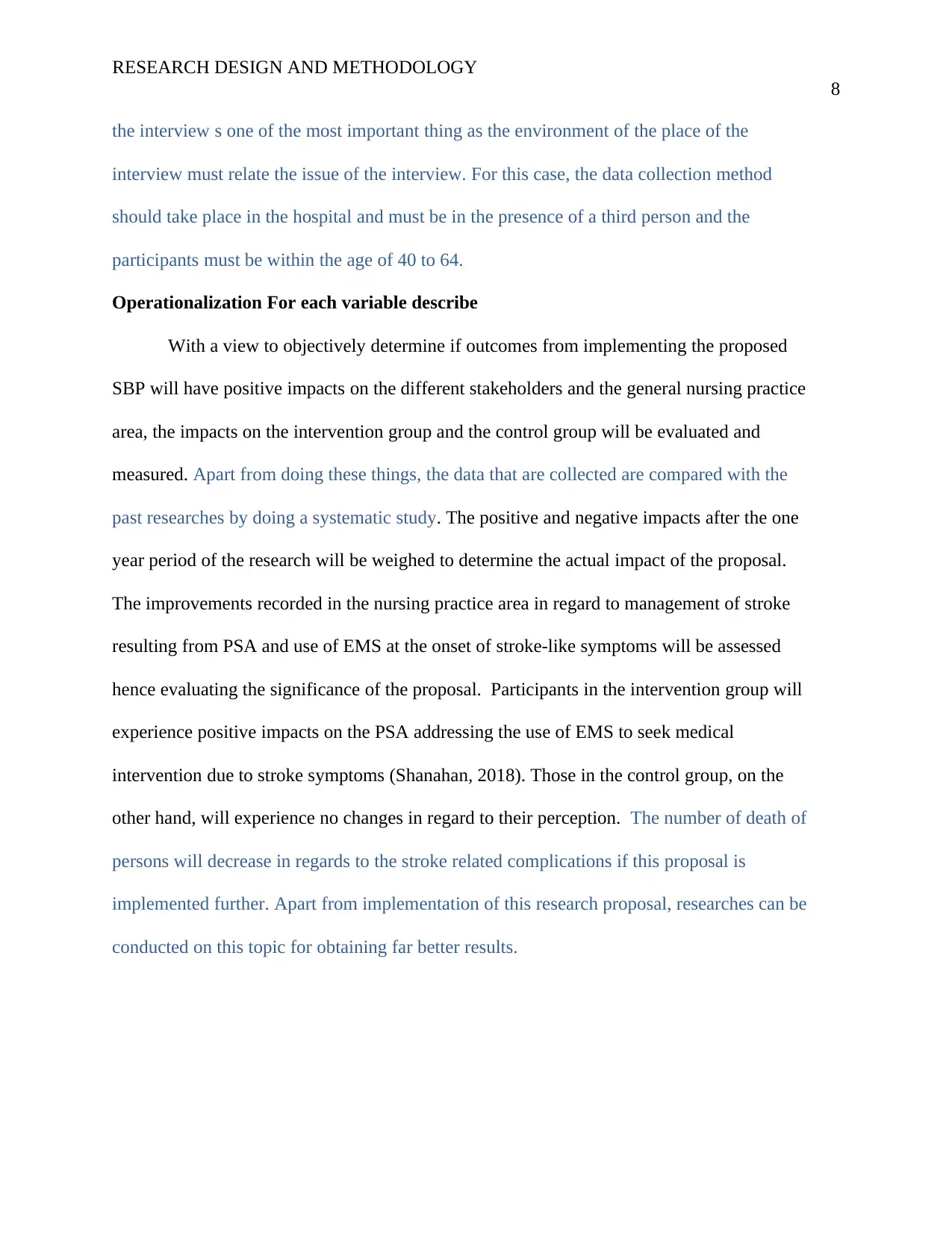
RESEARCH DESIGN AND METHODOLOGY
8
the interview s one of the most important thing as the environment of the place of the
interview must relate the issue of the interview. For this case, the data collection method
should take place in the hospital and must be in the presence of a third person and the
participants must be within the age of 40 to 64.
Operationalization For each variable describe
With a view to objectively determine if outcomes from implementing the proposed
SBP will have positive impacts on the different stakeholders and the general nursing practice
area, the impacts on the intervention group and the control group will be evaluated and
measured. Apart from doing these things, the data that are collected are compared with the
past researches by doing a systematic study. The positive and negative impacts after the one
year period of the research will be weighed to determine the actual impact of the proposal.
The improvements recorded in the nursing practice area in regard to management of stroke
resulting from PSA and use of EMS at the onset of stroke-like symptoms will be assessed
hence evaluating the significance of the proposal. Participants in the intervention group will
experience positive impacts on the PSA addressing the use of EMS to seek medical
intervention due to stroke symptoms (Shanahan, 2018). Those in the control group, on the
other hand, will experience no changes in regard to their perception. The number of death of
persons will decrease in regards to the stroke related complications if this proposal is
implemented further. Apart from implementation of this research proposal, researches can be
conducted on this topic for obtaining far better results.
8
the interview s one of the most important thing as the environment of the place of the
interview must relate the issue of the interview. For this case, the data collection method
should take place in the hospital and must be in the presence of a third person and the
participants must be within the age of 40 to 64.
Operationalization For each variable describe
With a view to objectively determine if outcomes from implementing the proposed
SBP will have positive impacts on the different stakeholders and the general nursing practice
area, the impacts on the intervention group and the control group will be evaluated and
measured. Apart from doing these things, the data that are collected are compared with the
past researches by doing a systematic study. The positive and negative impacts after the one
year period of the research will be weighed to determine the actual impact of the proposal.
The improvements recorded in the nursing practice area in regard to management of stroke
resulting from PSA and use of EMS at the onset of stroke-like symptoms will be assessed
hence evaluating the significance of the proposal. Participants in the intervention group will
experience positive impacts on the PSA addressing the use of EMS to seek medical
intervention due to stroke symptoms (Shanahan, 2018). Those in the control group, on the
other hand, will experience no changes in regard to their perception. The number of death of
persons will decrease in regards to the stroke related complications if this proposal is
implemented further. Apart from implementation of this research proposal, researches can be
conducted on this topic for obtaining far better results.
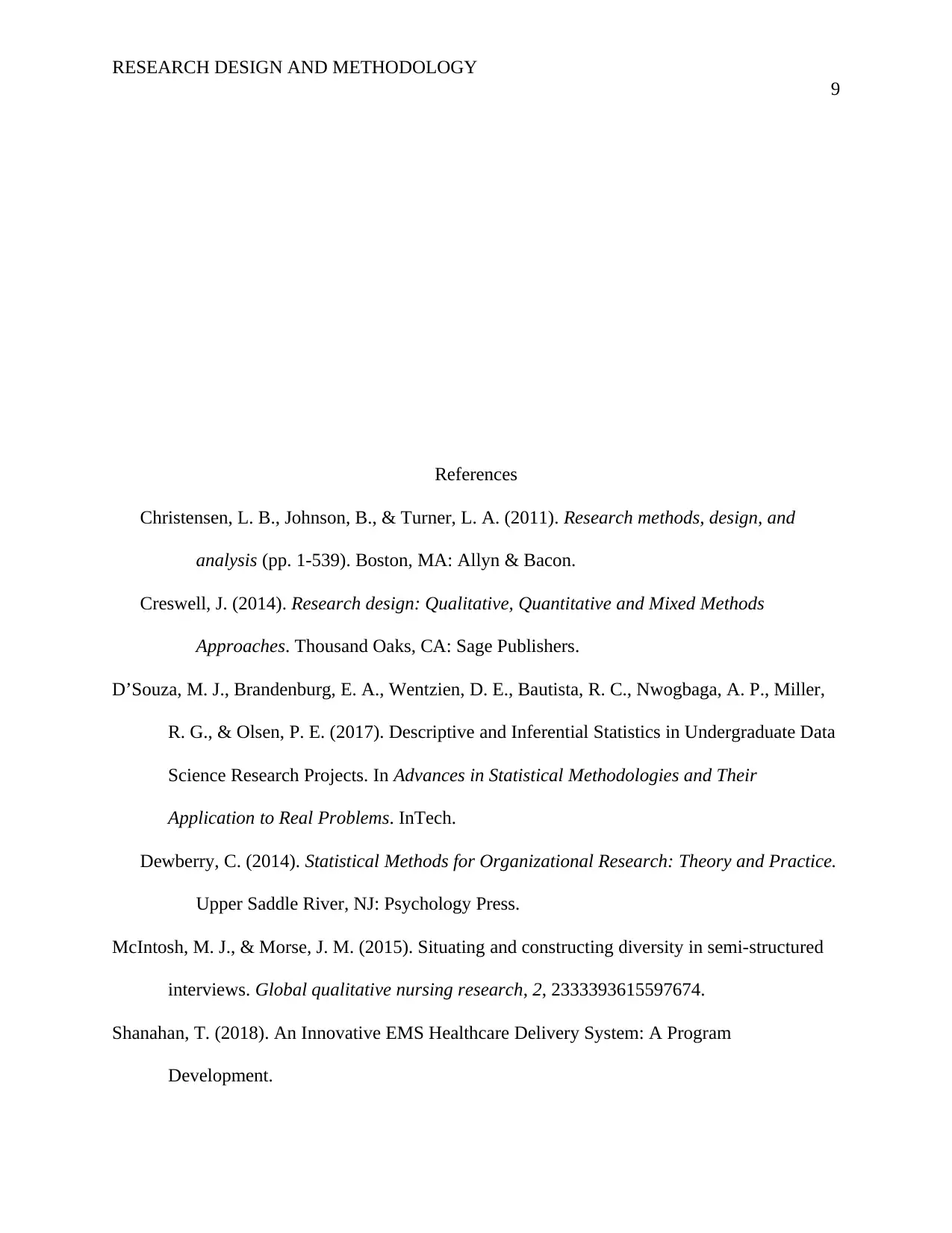
RESEARCH DESIGN AND METHODOLOGY
9
References
Christensen, L. B., Johnson, B., & Turner, L. A. (2011). Research methods, design, and
analysis (pp. 1-539). Boston, MA: Allyn & Bacon.
Creswell, J. (2014). Research design: Qualitative, Quantitative and Mixed Methods
Approaches. Thousand Oaks, CA: Sage Publishers.
D’Souza, M. J., Brandenburg, E. A., Wentzien, D. E., Bautista, R. C., Nwogbaga, A. P., Miller,
R. G., & Olsen, P. E. (2017). Descriptive and Inferential Statistics in Undergraduate Data
Science Research Projects. In Advances in Statistical Methodologies and Their
Application to Real Problems. InTech.
Dewberry, C. (2014). Statistical Methods for Organizational Research: Theory and Practice.
Upper Saddle River, NJ: Psychology Press.
McIntosh, M. J., & Morse, J. M. (2015). Situating and constructing diversity in semi-structured
interviews. Global qualitative nursing research, 2, 2333393615597674.
Shanahan, T. (2018). An Innovative EMS Healthcare Delivery System: A Program
Development.
9
References
Christensen, L. B., Johnson, B., & Turner, L. A. (2011). Research methods, design, and
analysis (pp. 1-539). Boston, MA: Allyn & Bacon.
Creswell, J. (2014). Research design: Qualitative, Quantitative and Mixed Methods
Approaches. Thousand Oaks, CA: Sage Publishers.
D’Souza, M. J., Brandenburg, E. A., Wentzien, D. E., Bautista, R. C., Nwogbaga, A. P., Miller,
R. G., & Olsen, P. E. (2017). Descriptive and Inferential Statistics in Undergraduate Data
Science Research Projects. In Advances in Statistical Methodologies and Their
Application to Real Problems. InTech.
Dewberry, C. (2014). Statistical Methods for Organizational Research: Theory and Practice.
Upper Saddle River, NJ: Psychology Press.
McIntosh, M. J., & Morse, J. M. (2015). Situating and constructing diversity in semi-structured
interviews. Global qualitative nursing research, 2, 2333393615597674.
Shanahan, T. (2018). An Innovative EMS Healthcare Delivery System: A Program
Development.
⊘ This is a preview!⊘
Do you want full access?
Subscribe today to unlock all pages.

Trusted by 1+ million students worldwide

RESEARCH DESIGN AND METHODOLOGY
10
Tavakol, M., & Sandars, J. (2014). Quantitative and qualitative methods in medical education
research: AMEE Guide No 90: Part II. Medical teacher, 36(10), 838-848.
10
Tavakol, M., & Sandars, J. (2014). Quantitative and qualitative methods in medical education
research: AMEE Guide No 90: Part II. Medical teacher, 36(10), 838-848.
1 out of 10
Related Documents
Your All-in-One AI-Powered Toolkit for Academic Success.
+13062052269
info@desklib.com
Available 24*7 on WhatsApp / Email
![[object Object]](/_next/static/media/star-bottom.7253800d.svg)
Unlock your academic potential
Copyright © 2020–2025 A2Z Services. All Rights Reserved. Developed and managed by ZUCOL.





